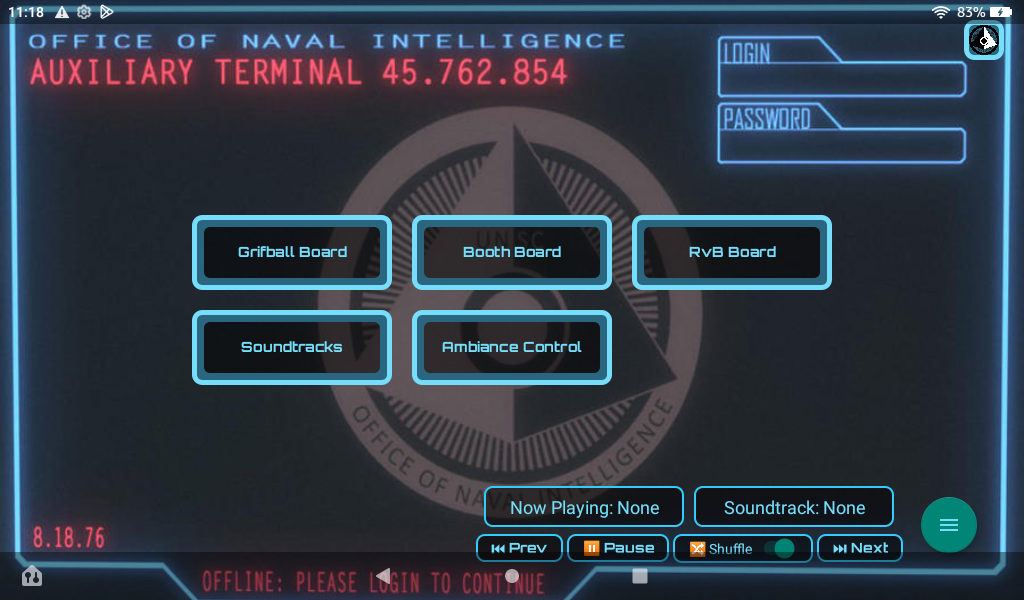UNSC Data pad - Soundboard
This Android-based soundboard was originally developed for two Halo-themed cosplay groups, expanding quickly into a full booth sound system capable of playing music, ambient tracks, and character soundbites from the franchise. Built entirely in Kotlin, it became my first Android application deployed at scale.
Developed in under a week, this project demonstrates my ability to rapidly prototype functional applications, adapt to new platforms, and support themed interactive experiences with responsive design and modular audio playback.

Grifball Board – Phoenix Fan Fusion
This soundboard was originally built for a special live event called Grifball Training, hosted at Phoenix Fan Fusion. Kids attending the convention were invited to run a themed obstacle course where they could “train” against cosplayed Spartans and ODSTs.
The app’s role was to provide:
Ambient soundtracks to set the scene
Sound cues for event start, end, and scoring interactions
Real-time button playback when a participant successfully hit (or missed) a Spartan
Visual feedback and cooldowns to help operators manage timing and pacing during the experience
This version of the app used a dual-audio system—one player for continuous ambiance and another for interactive soundbyte triggers—resulting in a seamless atmosphere for attendees.
The success of this project laid the foundation for a modular playback system and UI that’s now used across other fragments in the app.
Expanded Scope – From Grifball to Full Event Integration
What started as a targeted soundboard for Grifball Training soon grew into a multi-zone audio controller used across the entire convention booth. Recognizing the potential for broader impact, the project’s scope was expanded before the event to serve multiple cosplay teams and interactive areas.
This shift introduced:
Fragmented layout for modular booth sections (Grifball, Ambiance, Soundtrack, Booth FX)
Dual-audio playback systems for managing ambient loops and live soundbites simultaneously
Centralized sound management accessible through intuitive button interfaces
Manifest-driven soundtrack loading, enabling each group to tailor its own musical vibe
The result was a scalable, stable, and immersive sound experience that supported layered storytelling across the booth. And because the system was built to compile audio into the app, it remained secure, IP-compliant, and easy to distribute among cosplay operators.
Soundboard System – Dynamic Booth Playbac
The final piece of the app’s evolution is its customizable soundboard interface, designed to play voice lines and sound effects over the ambient and soundtrack layers. These soundboards are dynamically loaded from the assets/booth folder at runtime, giving booth operators real-time control over interactions without needing to recompile the app.
Key Features
Reads all sound files defined in a
SoundItemmanifest or hardcoded listSupports queued playback to prevent audio overlap
Restores soundtrack volume after sound effect completion
Allows cosplay groups to tailor booth experiences by swapping or editing sound content
This module enables spontaneous responses from booth actors—Spartans, ODSTs, or characters—triggered through labeled buttons with cooldowns and animated feedback. Whether a kid scores a hit during Grifball training or a dramatic Halo line needs to echo through the crowd, the soundboard ensures it happens cleanly.
It’s the final touch that brings the app to life in noisy, high-energy cosplay settings
Download
Audio Assets Not Included
Due to copyright restrictions, the app does not include Halo franchise audio files. However, the modular playback system and UI functionality are fully implemented and available for testing.
Try It Yourself
Feel free to download the Android build and explore the app through an emulator or device. I continue to update and refine the project to better support the cosplay groups who use it.
Watch the Demo
A video walkthrough is available below, showcasing the app’s functionality and a guided overview of the codebase.



